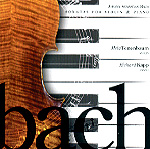For my comments on Bach’s Sonatas for Violin & Harpsichord with this same violinist, type Q4882 in Search Reviews. For a recording that makes the best possible case for hearing these works with piano, listen to this disc. Here pianist Richard Kapp and violinist Mela Tenenbaum offer performances of uncommon clarity–performances that, owing to the bright, clean-edged timbre of the modern violin and to the sparkling, pearly tone of Kapp’s piano, spring from the speakers with an ear-catching immediacy and freshness while remaining absolutely faithful to Bach’s score. (Don’t be thrown off by the incorrect listing of BWV 1014 as “A minor” rather than “B minor” on the disc’s back cover.) No excessive liberties are taken with ornamentation nor do any other self-indulgent mannerisms intrude, but there’s an overarching ease of delivery, a dancing playfulness to these performances that bespeaks mature, thoughtful artists at work–artists who also are having fun in the process.
Total timings for each sonata are uniformly shorter in these violin/piano versions, with markedly quicker tempos for all of the fast movements. As Kapp thoroughly explains in the liner notes, this has to do with specific characteristics of key action and the considerable differences in articulation, decay of sound, and relative expressive limitations of the two keyboard instruments. What it means for the listener is that Tenenbaum and Kapp go like lightning through the Allegros–but with absolutely clear, sharp-focused, evenly weighted attacks and an unforced rhythmic drive that gives exciting momentum and energy to the lines. Tenenbaum successfully used an early-19th century violin for her recording of these same works with harpsichord (Essay 1064/65), and her modern violin makes an equally complementary partner to the piano. Which is to say that the two players have figured out how to maintain ideal balances for each configuration–and within each sonata, where different voicings and textures present ongoing challenges. If anything, the sound for this recording is even more successful than the violin/harpsichord production in realistically capturing the full range and tonal qualities of each instrument.
































